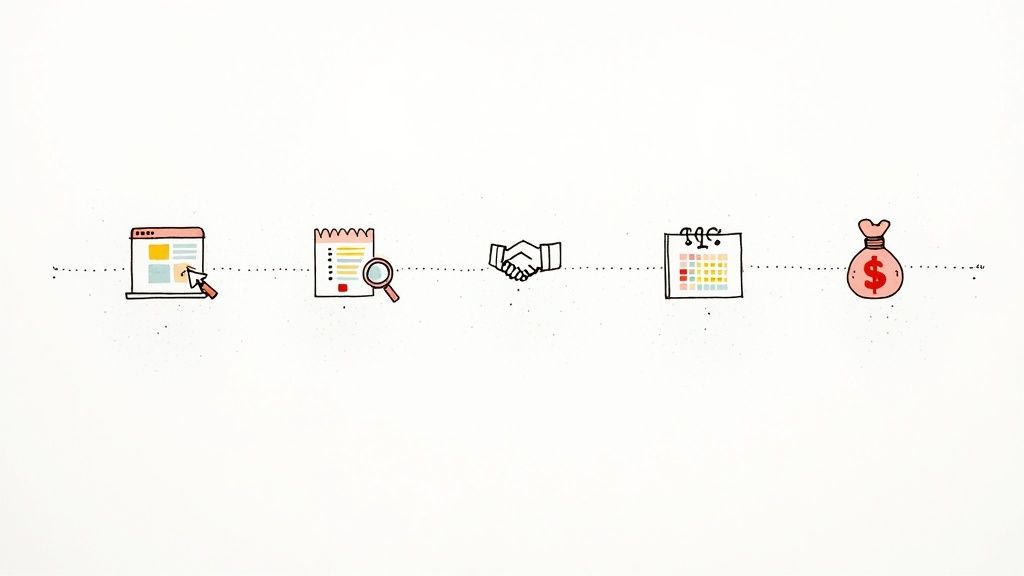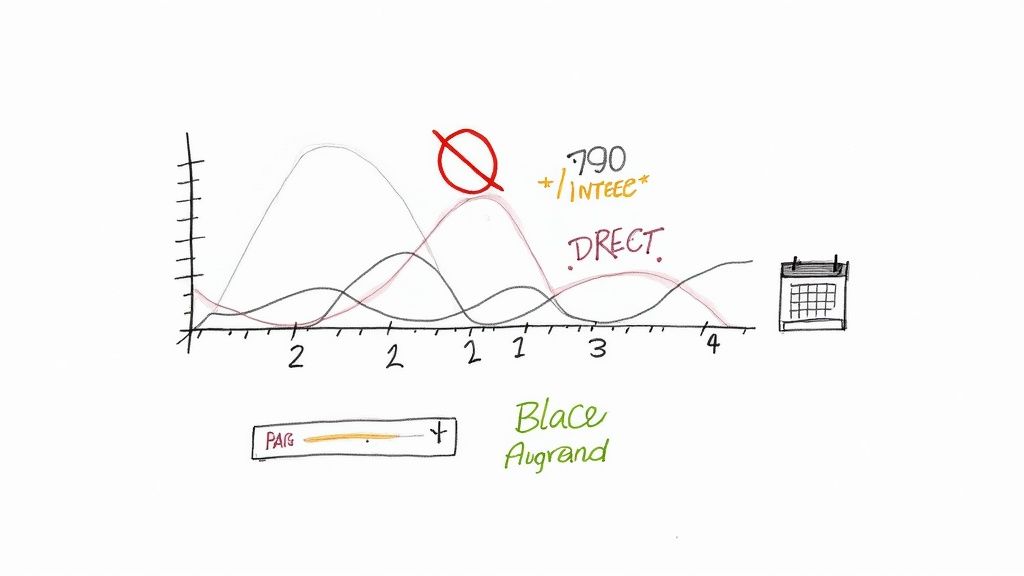
strategies for direct vacation rental bookings
Top 5 strategies for direct vacation rental bookings
Posted on Oct 22, 2025

While Online Travel Agencies (OTAs) like Airbnb and Vrbo are powerful for visibility, they come at a significant cost. Commissions can erode 15-20% of your earnings, and dependence on these platforms limits your control. The most profitable path forward lies in mastering the art of direct bookings, which builds brand equity, fosters guest loyalty, and puts you in complete command of your business.
This guide moves beyond generic advice to provide a concrete roadmap. We will dive into 10 actionable, data-backed strategies for direct vacation rental bookings designed to grow your independent revenue stream. To truly unlock your revenue potential, implementing a proven booking marketing strategy designed to attract the right guests is paramount.
From dominating local search results with advanced SEO to creating a frictionless, high-converting checkout experience, these tactics are used by top property managers to build sustainable, commission-free businesses. You will learn how to implement everything from guest loyalty programs to targeted paid advertising campaigns. This comprehensive list provides the specific steps and insights needed to reclaim your revenue and build a more resilient vacation rental operation.
1. Search Engine Optimization (SEO) for Vacation Rental Websites
Search Engine Optimization (SEO) is the art and science of making your direct booking website more visible to travelers using search engines like Google. When potential guests search for terms like "beachfront cabin rental in Outer Banks," a strong SEO strategy ensures your property appears on the first page, capturing highly qualified, booking-ready traffic without paying for ads. This is one of the most sustainable, long-term strategies for direct vacation rental bookings, building an asset that generates leads consistently over time.
For example, Natural Retreats famously increased direct bookings by 40% by creating in-depth, location-specific content that outranked major OTAs for niche travel queries.
How to Implement SEO
To effectively harness SEO, focus on both content and technical elements:
- Create Hyper-Local Content: Write detailed property descriptions (aim for 500+ words) and build dedicated landing pages for each property or neighborhood. Create a comprehensive guide to local attractions, restaurants, and activities that answers common traveler questions.
- Implement Technical SEO: Ensure your website is mobile-friendly and loads quickly. Use vacation rental schema markup, a specific code that helps Google display your pricing, availability, and guest ratings directly in search results.
- Build Local Authority: Earn backlinks (links from other websites to yours) from local tourism boards, chambers of commerce, and travel blogs to signal your website's credibility to search engines.
Pro Tip: Use Google Search Console (a free tool) to discover the exact search terms people are already using to find your site. Optimize your content around these proven queries to quickly improve your rankings.
2. Email Marketing and Guest Nurture Campaigns
Email marketing is a powerful tool for converting one-time renters into repeat direct bookers. By building a list of past guests and potential leads, you can create a direct communication channel you own, independent of OTA algorithms. This strategy nurtures relationships over time, keeping your properties top-of-mind and encouraging loyalty, making it one of the most cost-effective strategies for direct vacation rental bookings with the highest ROI.
For instance, Vacasa, a major property management company, reports that an impressive 35% of their bookings originate from email marketing campaigns targeting past guests.
How to Implement Email Marketing
A successful email strategy relies on segmentation and automation to deliver timely, relevant messages:
- Build Your List: Actively collect emails at every touchpoint. Use exit-intent popups on your website offering a free local guide, add a sign-up form to your booking process, and capture contact information from inquiries.
- Automate Nurture Sequences: Create automated email series for specific triggers. This includes abandoned booking reminders sent within an hour, pre-arrival guides with upsell opportunities, and post-stay follow-ups that request reviews and offer a "book direct" discount for their next trip.
- Segment and Personalize: Group your audience based on their past booking history, property preferences, or inquiry details. Send targeted campaigns about last-minute availability for their favorite cabin or a seasonal promotion for the type of beachfront property they previously booked.
Pro Tip: Create a dedicated "OTA guest conversion" campaign. Three to six months after a guest checks out from an OTA booking, send them an exclusive offer to book their next stay directly with you, highlighting the savings and extra perks. For a deeper dive, explore The Ultimate Guide to Guest Rebooking Emails on gethostai.com.
3. Dynamic Pricing and Direct Booking Incentives
Dynamic pricing combines revenue management science with strategic incentives to make your direct booking channel the most attractive option for guests. This approach involves using algorithms to adjust rental rates based on real-time factors like seasonality, local events, demand, and competitor pricing. By pairing this intelligent pricing with exclusive direct-booking discounts, you create a compelling financial reason for guests to bypass Online Travel Agencies (OTAs) and book straight from the source.
For example, a luxury villa company in Tuscany increased its direct revenue by 55% simply by matching Airbnb’s price but subtracting the 15% guest service fee, making the savings transparent and immediate for the booker.

How to Implement Dynamic Pricing and Incentives
To successfully blend pricing automation with direct booking perks, focus on transparency and value:
- Offer Clear Financial Incentives: Don't just lower the price; show the savings. Display a crossed-out OTA price next to your direct rate, with a clear message like, "Book Direct & Save $127 (vs. Airbnb)." This psychological pricing anchor makes the value proposition undeniable.
- Bundle Exclusive Value-Adds: Instead of only offering a discount, provide exclusive perks for direct bookers. This could include a complimentary late checkout, a welcome basket, free mid-stay cleaning, or an airport transfer, enhancing the guest experience without deeply cutting into your margins.
- Use Pricing Tools to Stay Competitive: Implement dynamic pricing software like PriceLabs or Wheelhouse to automate rate adjustments. These tools analyze market data to fill last-minute gaps and maximize revenue during peak periods, ensuring you're always competitively positioned. To get started, you can explore more about vacation rental revenue management on gethostai.com.
Pro Tip: Create urgency by offering limited-time "flash sales" exclusively for your email subscribers or social media followers. A 48-hour sale offering a 15% direct booking discount can drive a significant surge in bookings and reward your loyal audience.
4. Google Ads and Paid Search Campaigns
Google Ads and paid search campaigns offer one of the most direct strategies for direct vacation rental bookings by placing your property in front of travelers at the exact moment they are ready to book. Unlike SEO, which takes time, paid search provides immediate visibility. When a potential guest searches for high-intent keywords like "book vacation home in Sedona," your targeted ad appears at the top of the search results, driving qualified traffic directly to your booking page.
For instance, a Florida vacation rental company generated 32% of its direct bookings by running Google Ads campaigns specifically targeting last-minute "available this weekend" searches, capturing travelers with urgent booking needs.
How to Implement Paid Search
To launch a successful campaign and maximize your return on ad spend, focus on precision and relevance:
- Target High-Intent Keywords: Allocate the majority of your budget to "transactional" keywords that include terms like "book," "rent," or "reserve." Use geographic modifiers like "downtown" or "beachfront" to attract highly specific searchers.
- Create Optimized Landing Pages: Do not send ad traffic to your homepage. Instead, create dedicated landing pages for each ad group that perfectly match the search intent, featuring clear calls-to-action and prominent booking forms.
- Leverage Remarketing: Implement remarketing campaigns at a lower bid to show targeted ads to users who previously visited your website but didn't book. This keeps your property top-of-mind and recaptures potential guests.
Pro Tip: Protect your brand from OTA hijacking by bidding on your own property and company names. This ensures that when someone searches for you directly, your official website appears first, not a listing on an OTA that will take a commission.
5. Professional Photography and Virtual Tours
High-quality visual content is not a luxury; it's the single most persuasive tool for converting lookers into bookers on your direct booking website. Professional photography, 360° virtual tours, and drone footage emotionally connect with potential guests, allowing them to envision themselves in the space long before they arrive. This investment directly addresses guest uncertainty, builds trust, and justifies premium pricing, making it one of the highest ROI strategies for direct vacation rental bookings.

For example, Airbnb's internal data famously revealed that listings with professional photos earn up to 40% more revenue. Similarly, a luxury villa operator in Costa Rica increased direct bookings by a staggering 67% after investing in a comprehensive photography package that included drone footage showcasing the property's stunning location.
How to Implement Visual Content
To maximize the impact of your property’s visuals, adopt a multi-format, strategic approach:
- Invest in Professional Photography: Hire a photographer specializing in real estate or hospitality. Declutter and stage the property with neutral, aspirational styling. Capture unique features like a hot tub, game room, or stunning view, and include lifestyle shots showing spaces in use.
- Create Immersive Virtual Tours: Use technology like Matterport to create 3D virtual tours. These tours allow guests to digitally walk through the property, significantly reducing pre-booking questions and building confidence. For even more immersive pre-booking experiences, exploring the potential of augmented reality in travel can provide potential guests with a richer journey before they even arrive.
- Leverage Drone and Video Footage: For properties with unique settings (waterfront, mountain views, large acreage), drone footage provides unparalleled context and a "wow" factor. Create short, 60-90 second video walkthroughs optimized for social media and your website.
Pro Tip: Schedule your photoshoot during the "golden hour" (just after sunrise or before sunset) for warm, inviting light. Update your photos seasonally to show the property's year-round appeal, such as a cozy fireplace in winter or a blooming garden in spring.
6. Guest Loyalty and Referral Programs
Guest loyalty and referral programs transform one-time guests into repeat customers and brand advocates, creating a powerful, self-sustaining direct booking engine. By rewarding past guests for their loyalty and for spreading the word, you build a community around your brand, significantly reduce marketing costs, and increase guest lifetime value. This is one of the most effective strategies for direct vacation rental bookings because it capitalizes on your most valuable asset: happy guests.
For example, Evolve Vacation Rental Network reports that an impressive 38% of their bookings come from repeat guests who are part of their loyalty initiatives, demonstrating the immense power of incentivizing return visits.
How to Implement Loyalty and Referral Programs
To launch an effective program, focus on making it simple, valuable, and easy to share:
- Design a Tiered Loyalty System: Create a multi-level program that offers increasing rewards. Start with a simple discount on a second stay and scale up to perks like early check-in, a complimentary welcome basket, or a free night for top-tier members.
- Launch a Frictionless Referral Process: Provide guests with a unique, shareable link that automatically applies a credit or discount for both the referrer and the new guest. This makes word-of-mouth marketing effortless and trackable.
- Communicate Value Consistently: Automatically enroll all past guests to kickstart the program. Send regular, automated emails updating them on their loyalty status, available rewards, and the savings they’ve accumulated by booking direct.
Pro Tip: Set the first reward threshold low (e.g., a 10% discount on their second stay) to demonstrate the program's value quickly. This initial positive reinforcement encourages long-term engagement and makes guests feel appreciated from the start.
7. Social Media Marketing and Influencer Partnerships
Social media marketing uses platforms like Instagram, Facebook, and TikTok to build brand awareness, engage potential guests visually, and drive traffic directly to your booking website. This strategy transforms passive scrolling into active booking interest by showcasing your property’s unique lifestyle and experience, making it one of the most effective strategies for direct vacation rental bookings when done correctly.

For example, UK-based Unique Homestays built an Instagram-first strategy that now drives 40% of its direct bookings. Similarly, a single viral TikTok video showcasing a waterfront property generated over $45,000 in direct revenue for BeachBound vacation rentals.
How to Implement Social Media Marketing
To leverage social media effectively, combine consistent content with targeted partnerships and advertising:
- Create Platform-Specific Content: Post polished, high-resolution photos on Instagram, share lifestyle-focused short-form videos on TikTok and Reels, and create inspirational destination boards on Pinterest. Consistency is key; aim for 3-5 posts per week.
- Partner with Influencers: Collaborate with micro-influencers (10k-100k followers) who often have higher engagement rates and are more cost-effective. A partnership can expose your property to a highly targeted, travel-focused audience.
- Run Targeted Ad Campaigns: Use Facebook and Instagram ads to retarget visitors who viewed your website but didn't book. Create campaigns targeting specific demographics, such as families in nearby states looking for a weekend getaway.
Pro Tip: Encourage user-generated content (UGC) by creating a unique hashtag for your property and asking guests to tag you in their posts. Sharing guest photos provides authentic social proof and a steady stream of content for your feed.
8. Content Marketing and Destination Guides
Content marketing attracts travelers during their initial research phase by providing valuable, free information about your destination. Instead of directly selling your property, you create comprehensive destination guides, itineraries, and blog posts that answer traveler questions. This positions you as a local expert, builds trust, and drives organic traffic from search engines, which you can then nurture toward a direct booking. It's a powerful strategy for capturing guests before they even start browsing OTAs.
For instance, the Charleston vacation rental company that created the "Complete Guide to Charleston Beaches" now ranks #1 on Google for that term. This single piece of content drives thousands of visitors monthly and converts a significant percentage directly into bookings, demonstrating the high ROI of destination-focused content.
How to Implement Content Marketing
To build a content engine that drives direct bookings, focus on creating genuinely helpful resources:
- Create "Ultimate" Guides: Develop comprehensive, long-form guides (2,000+ words) covering major topics like "Things to Do in [Your City]" or "A Family's Guide to [Your Destination]." These pillar pages attract significant search traffic and establish authority.
- Target Informational Keywords: Use free tools like Google Keyword Planner to find what travelers are searching for. Target queries like "best restaurants in [neighborhood]" or "hiking trails near [town]" and create content that directly answers these questions.
- Embed Properties Naturally: Within your guides, strategically recommend your properties where relevant. For example, in a post about the best local beaches, you can mention, "For easy walking access to this beach, consider staying at our Sandpiper Cottage."
Pro Tip: Create content hubs organized by traveler type, such as "Family Getaways," "Romantic Escapes," or "Adventure Trips." This allows you to tailor recommendations and makes it easier for potential guests to find the perfect property for their specific needs.
9. Website Optimization and Conversion Rate Improvement
Website optimization is the process of refining your direct booking site to turn more visitors into paying guests, a practice known as Conversion Rate Optimization (CRO). It involves improving design, user experience (UX), and functionality to remove friction from the booking process. Driving traffic is only half the battle; an optimized website ensures that traffic converts, maximizing the return on your marketing efforts and solidifying your direct booking strategy.

For example, one luxury villa operator increased its conversion rate from 2.1% to 3.8% just by simplifying its booking process, generating an additional $127,000 in annual revenue from the same amount of website traffic. This shows how small tweaks can yield significant financial gains.
How to Implement Website Optimization
To convert more lookers into bookers, focus on building trust and making the path to purchase as easy as possible:
- Streamline the Booking Process: Place your booking widget "above the fold" on all pages. Minimize the number of form fields required to book, asking only for essential information. Ensure the entire process is mobile-friendly, as over 60% of searches happen on mobile devices.
- Build Trust and Social Proof: Display trust badges like SSL security certificates and payment processor logos. Prominently feature recent 5-star guest reviews and testimonials to build credibility with potential guests.
- Create Clear Calls-to-Action (CTAs): Use high-contrast, action-oriented buttons like "Book Now" or "Check Availability." A/B test different button colors, text, and placements to see what drives the most clicks. For more details on what your site needs, explore these must-have features for a high-converting short-term rental website.
Pro Tip: Use a heat mapping tool like Hotjar or Crazy Egg to see exactly where visitors click, scroll, and drop off on your website. These insights reveal user behavior, allowing you to identify and fix friction points in the booking journey with precision.
10. Booking Flow and Checkout Optimization
Booking flow and checkout optimization involves refining the final steps a guest takes to make a reservation on your website. A clunky, confusing, or lengthy checkout process is a primary cause of booking abandonment, turning a motivated guest into a lost sale at the last second. By streamlining this journey, you reduce friction and maximize the number of visitors who complete their transactions, making it one of the highest-impact strategies for direct vacation rental bookings.
For example, a property management group famously reduced its cart abandonment rate by 28% after consolidating a complex six-step checkout process into a single, intuitive page.
How to Implement Checkout Optimization
To convert more lookers into bookers, your checkout must be seamless, transparent, and trustworthy:
- Simplify the Process: Minimize the number of clicks and required fields. Offer a "guest checkout" option to avoid forcing new users to create an account, which can be a significant barrier.
- Ensure Price Transparency: Display the total price, including all taxes and fees, as early as possible. Surprising guests with hidden costs on the final payment screen is a guaranteed way to lose their trust and the booking.
- Build Trust and Offer Flexibility: Showcase secure payment icons (Visa, Mastercard, Stripe) prominently. Offer multiple payment options, such as credit cards and digital wallets like PayPal or Apple Pay, to cater to guest preferences.
Pro Tip: Implement an abandoned booking recovery sequence. Send an automated email within one hour to guests who started but didn't complete a booking. Include a direct link to resume their checkout and consider offering a small, time-sensitive incentive to encourage completion.
10-Point Direct Booking Strategy Comparison
| Strategy | Implementation complexity | Resource requirements | Expected outcomes & timeframe | Ideal use cases | Key advantages |
|---|---|---|---|---|---|
| Search Engine Optimization (SEO) for Vacation Rental Websites | Medium–High (technical + content) | Content writers, developer/SEO specialist; $0–$5k+/mo (DIY to agency) | Sustainable organic traffic; measurable lift in 3–6 months, stronger by 6–12 months | Properties targeting long-term direct bookings and local searches | Lower CAC, builds authority, captures high-intent travelers |
| Email Marketing and Guest Nurture Campaigns | Low–Medium (automation setup + content) | Email platform $0–$300/mo; copy/design resources; list growth time | High ROI; quick wins in weeks; typical conversion 15–25% (past guests) | Owners with guest lists, retention and rebooking focus | Highest ROI, owned channel, highly personalized re-engagement |
| Dynamic Pricing and Direct Booking Incentives | Medium–High (software + rules) | Pricing software $20–$400/mo; historical data and revenue management expertise | Immediate revenue optimization; 10–40% increase in direct booking revenue potential | Portfolios in seasonal or event-driven markets | Maximizes revenue, fills gaps, data-driven pricing |
| Google Ads and Paid Search Campaigns | Medium–High (campaign setup + optimization) | Ad spend $500–$5k+/mo; PPC expertise or agency fees | Immediate traffic and leads; typical ROI 3:1–8:1 when optimized; measurable CPA | Short-term promotions, last-minute inventory, high-intent search capture | Fast visibility, targetable by intent/location, scalable |
| Professional Photography and Virtual Tours | Low–Medium (one-time project) | Photographer/VR provider; $300–$2,500+ per property; staging as needed | Higher conversion rates (≈30–40%); strong ROI often within first year | Luxury or highly visual properties and competitive listings | Increases conversions, justifies premium pricing, reusable assets |
| Guest Loyalty and Referral Programs | Medium (program design + tracking) | Loyalty platform or tracking; $0–$500 setup; rewards cost ~5–15% revenue | Increases repeat bookings (20–40%) and customer LTV; results over months | Portfolios with repeat guests or multi-property brands | Lowers acquisition cost, drives referrals, increases lifetime value |
| Social Media Marketing and Influencer Partnerships | Medium (content + community management) | Time or $300–$3k+/mo for ads; influencer fees $500–$5k+ per campaign | Brand awareness and engagement; direct bookings variable, viral hits possible | Visually appealing properties targeting younger demographics | Visual storytelling, UGC, authentic third‑party validation |
| Content Marketing and Destination Guides | Medium–High (research + production) | Writers/SEO; $0–$3k+/mo for professional content | Attracts early-stage travelers; SEO benefits in 3–6 months; 20–50% annual traffic growth with consistency | Properties wanting to capture research-phase traffic and build email lists | Builds authority, evergreen traffic, email lead capture |
| Website Optimization and Conversion Rate Improvement | Medium–High (UX + technical) | Developer/designer, testing tools; variable cost | Improves conversion rate (even 1–2% uplift yields large revenue); effects seen immediately to months | Sites with traffic but low conversion or high bounce | Maximizes ROI of all marketing, reduces friction, improves trust |
| Booking Flow and Checkout Optimization | Medium (UX + payments integration) | Dev work, secure payment integrations, A/B testing | Reduces abandonment; measurable conversion uplift (e.g., 12–28%); immediate impact after changes | High-abandonment funnels and first-time bookers | Increases completed bookings, faster repeat bookings, improved user satisfaction |
Building Your Direct Booking Engine
Transitioning your vacation rental business from a state of heavy reliance on Online Travel Agencies (OTAs) to a thriving direct booking model is a marathon, not a sprint. The journey requires a strategic, multi-faceted approach, but the rewards of increased profitability, brand control, and direct guest relationships are immense. The strategies detailed throughout this article are not isolated tactics; they are interconnected components of a powerful, self-sustaining ecosystem designed to attract and convert travelers directly.
From Foundation to Flywheel
The key to long-term success lies in building momentum. Think of it as creating a flywheel effect where each action adds energy and accelerates the next. Your journey begins with the non-negotiable foundation: a high-converting, mobile-friendly website equipped with professional photography, immersive virtual tours, and a frictionless booking flow. Without these core elements, any traffic you generate from other efforts will fail to convert, wasting both time and resources.
Once your digital storefront is optimized, you can begin layering on the strategies that drive sustainable growth. SEO and content marketing, for instance, are the long-term engines that build organic visibility and establish your brand as a trusted authority on your destination. These efforts work in concert with more immediate tactics like targeted Google Ads and dynamic pricing incentives, which can drive qualified traffic and secure bookings in the short term. The final, crucial layer involves maximizing the lifetime value of every guest. This is where a robust email marketing strategy and a well-structured guest loyalty program come into play, transforming one-time visitors into repeat customers and passionate brand advocates.
The Power of a Unified System
Implementing these diverse strategies for direct vacation rental bookings can seem daunting, especially when juggling multiple tools and platforms. The most successful operators understand that integration is the key to efficiency and scale. When your website, email campaigns, advertising efforts, and guest communication are all part of a cohesive system, you unlock powerful automation and data-driven insights. This unified approach eliminates friction not just for you, but more importantly, for your guests, creating a seamless experience from their first click to their post-stay follow-up.
By systematically applying these principles, you are not just capturing bookings; you are building a resilient, independent, and more profitable business. You are moving from being a listing on a third-party site to becoming a recognized, bookable brand that guests seek out directly. The control shifts back to you, empowering you to shape your own success.
Ready to unify your marketing and double your direct revenue without the complexity? hostAI combines an intelligent website builder, automated email marketing, and hands-free advertising into a single, powerful platform. Discover how hostAI can automate your growth by visiting hostAI today.